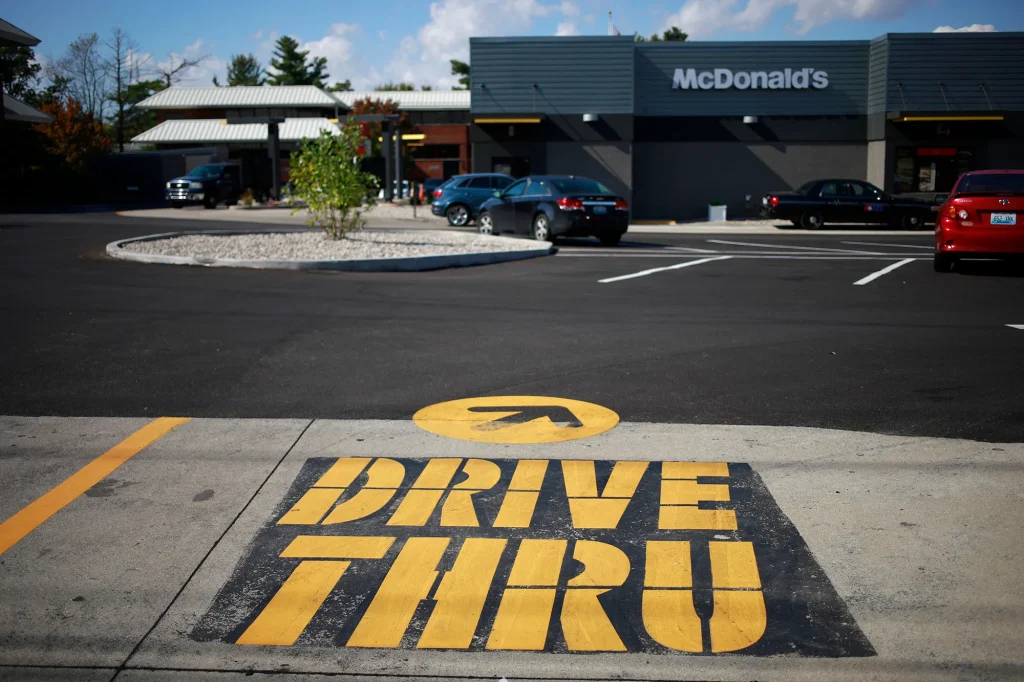Ticket McDonald’s Drive-Thru: What You Need to Know”
A recent incident involving a driver receiving a hefty fine for using the McDonald’s app while in a Ticket McDonald’s Drive-Thru has sparked a discussion on the legality of phone use in such scenarios.
Similarly, another incident involved a person checking their phone while idling in traffic. They faced charges, but the court’s decision was split. These instances highlight the grey areas in our current laws. They also underscore the need for clarity.

The Incident: A Costly Convenience
A Surprising Turn at the Drive-Thru
Imagine the surprise and frustration of being fined $580 for simply using the McDonald’s app to order food while waiting in line at the drive-thru. This unexpected penalty left one driver bewildered, showcasing the unforeseen pitfalls of blending technology with routine tasks.
The Fine Details The driver
while stationary in the drive-thru lane, decided to use the time to place their order through the app, thinking it a prudent use of waiting time. However, this action was met with a hefty fine, interpreted by authorities as illegal phone use while operating a vehicle, despite the car not being in motion.
Initial Shock and Response
Caught off guard by the fine, the driver’s initial shock quickly turned into a resolve to contest the charge. This decision not only highlighted the ambiguous nature of current traffic laws regarding mobile device use but also sparked a broader conversation about what constitutes responsible phone use in a vehicle, particularly in drive-thru scenarios.
Contesting the Fine: A Legal Battle Begins
Embarking on a quest to overturn the $580 fine, the driver engaged with the legal system, determined to shed light on the nuances of mobile device use in drive-thru lanes. Equipped with a firm belief in the misapplication of the law, they sought legal counsel, aiming to illustrate how stationary use of a phone in a drive-thru should not equate to the prohibited use while driving.
This challenge sparked a legal examination, inviting scrutiny over the precise interpretation of traffic laws as they pertain to modern technological conveniences. Furthermore, this situation opened the doors to a broader debate, encouraging authorities to revisit and potentially reevaluate regulations concerning mobile device usage in vehicles, particularly in non-traditional driving scenarios.
Understanding the Law: Mobile Device Use While Driving
Navigating the legal landscape of mobile device use while driving can often feel like a maze. Laws typically dictate that operating a phone without hands-free technology while driving is illegal, aiming to reduce distractions and enhance road safety.
Interestingly, these regulations evolve as technology becomes more intertwined with our daily routines, including how we order food. Consequently, the crux of the matter lies in distinguishing between active driving scenarios and stationary moments, such as waiting in a drive-thru.
This distinction is pivotal, as it shapes the debate on what is deemed lawful versus unlawful phone use behind the wheel. Furthermore, this situation underscores the importance of staying informed about current laws to ensure compliance and safeguard against unintended infractions.

Police Response: Clarifying the Rules
Initial Statement In response to the incident,
local police were quick to issue a clarifying statement. They emphasized the importance of understanding the specific circumstances under which mobile device use is deemed illegal while driving.
Intent Behind the Law
The police clarified that the intent behind the law is to reduce distractions and enhance safety on the roads. This includes minimizing phone usage while in control of a vehicle, even when stationary.
Drive-Thru Exception
Authorities pointed out a notable exception: using a mobile device while the vehicle is stationary in a drive-thru lane is not considered illegal. This distinction is crucial for drivers to grasp to avoid misunderstandings.
Public Education Effort
Following the incident, police undertook efforts to educate the public on safe mobile device use in vehicles. They stressed the importance of using hands-free options whenever possible, even in stationary situations.
Ongoing Dialogue
The police also expressed their commitment to an ongoing dialogue with the community. They aim to ensure laws are clearly understood and fairly enforced, keeping up with technological advancements and their implications on daily life.
Public Reaction: Community and Social Media
The public outcry was swift and vocal. Many took to social media. They aired their disbelief and frustration. “Unbelievable,” some commented. “Absurd,” said others. The incident became a trending topic. Discussions sprang up on platforms like Twitter and Facebook.
Some users shared similar experiences. They expressed sympathy for the fined driver. Others debated the nuances of the law. The online community rallied. They demanded clearer regulations. They emphasized fairness and common sense. Importantly, this digital uproar brought widespread attention. It sparked a valuable conversation.
This conversation transcended the immediate community. It engaged a broader audience. Indeed, the power of collective voices was evident. They made sure this issue couldn’t be ignored.
Legal Precedents: Previous Cases and Rulings
Interestingly, there aren’t many direct precedents. Yet, some cases have nudged the boundaries. For example, a driver was acquitted for using a GPS on their phone while stopped at a red light. This case raised eyebrows and prompted further discussion.
Indeed, as technology advances, these legal ambiguities become more pronounced. Each case, unique in its right, contributes to an evolving dialogue. They push for a reevaluation of laws. They also shape future interpretations.
Technological Solutions: Safe App Use in Vehicles
Hands-Free Integration
Modern vehicles now come equipped with built-in systems designed for hands-free operation, allowing drivers to navigate apps without taking their eyes off the road. This seamless integration ensures that you can place your drive-thru order while maintaining full attention on your surroundings, making it a safer alternative for everyone involved.
Voice Command Features
Voice command technology has advanced to a point where simply speaking your order into the vehicle’s system can execute app functions. This means less manual interaction with your device, minimizing distractions, and keeping your focus squarely on driving, even when you’re in line for a burger.
Custom App Settings for Driving
Some mobile apps offer settings specifically designed for use while driving, limiting the amount of screen interaction required. By enabling these features, drivers can ensure their use of the app adheres to safety standards, reducing the risk of accidents or fines.
Educational Campaigns on Safe Use
The industry has begun to roll out educational campaigns aimed at teaching drivers how to use their apps responsibly while on the road. These initiatives are crucial for promoting a culture of safety and awareness, helping to prevent misunderstandings, and encouraging compliance with local laws.

Fast-Food Industry Response: Policies and Practices
Implementing User-Friendly Features
The fast-food industry, recognizing the challenges and controversies surrounding mobile app use in vehicles, has begun to implement more user-friendly features. These enhancements aim to streamline the ordering process, making it less distracting and more intuitive for drivers.
Training Staff for Efficiency
Moreover, fast-food chains are investing in staff training to ensure orders placed through mobile apps are processed quickly and accurately. This reduces wait times in drive-thrus, minimizing the temptation for drivers to engage with their phones while waiting.
Encouraging Pre-Ordering
To further mitigate risks, the industry is promoting the concept of pre-ordering. By encouraging customers to place their orders before arriving at the drive-thru, the need for last-minute phone usage is substantially reduced.
Collaboration with Law Enforcement
Lastly, there is an emerging trend of collaboration between the fast-food industry and law enforcement agencies. Together, they work to educate the public on safe mobile app usage in and around drive-thrus, ensuring a safer experience for everyone involved.
How the McDonald’s App Plays a Role in Orders
The McDonald’s app is ingeniously crafted to provide a seamless ordering experience, revolutionizing the way we engage with fast food. By enabling customers to browse the menu, customize their orders, and pay directly from their smartphones, it epitomizes convenience at our fingertips.
Moreover, the app’s role extends beyond mere order placement. It bridges the gap between traditional and digital dining experiences, allowing for real-time updates on special deals, collecting rewards, and even pinpointing the nearest McDonald’s location for pick-up.
Conclusion of Ticket Mcdonalds Drive Thru
In wrapping up, the tale of the Ticket McDonald’s Drive-Thru serves as a poignant reminder of our evolving relationship with technology and the legal landscape. Seamlessly, it highlights the balance we must strike between leveraging digital conveniences and adhering to the rules of the road. AAVOT, we provide the latest apps, games, and tech news for enthusiasts, keeping you updated with trending downloads and expert recommendations.
Moreover, this story sheds light on the importance of legal clarity and the need for ongoing dialogue between law enforcement, the public, and industries at the forefront of technological integration. Ultimately, as we navigate these complex intersections, staying informed and proactive in understanding our rights and responsibilities becomes crucial.
FAQs
Can I Legally Use My Phone in a Drive-Thru?
Yes, using your mobile device to place orders while your vehicle is stationary in a drive-thru lane is not considered illegal. However, be mindful to not engage in phone use that distracts you from the environment around you.
What Should I Do If I’m Fined?
If you receive a fine for using your phone in a drive-thru, it’s advisable to contest it. Gather evidence that your vehicle was stationary at the time and seek legal advice on how to proceed.
Are There Safe Ways to Use My Phone in the Car?
Indeed, using hands-free technology or voice commands are safer alternatives that minimize distraction. Many modern vehicles and apps offer features designed to facilitate this.
How Can I Stay Informed About Traffic Laws?
Regularly checking official state or local government websites and following news from reputable sources can help you stay updated on changes to traffic laws regarding mobile device use.
Will Fast-Food Apps Adapt to These Legalities?
The fast-food industry is continually updating its apps to offer more user-friendly and safer ways for customers to place orders, including features that limit interaction while driving.






